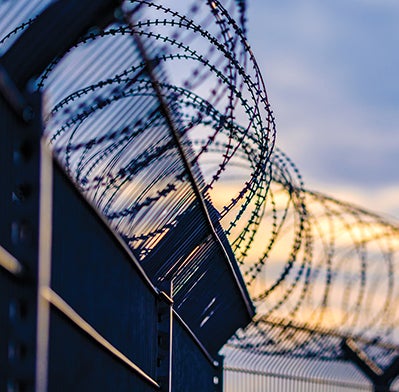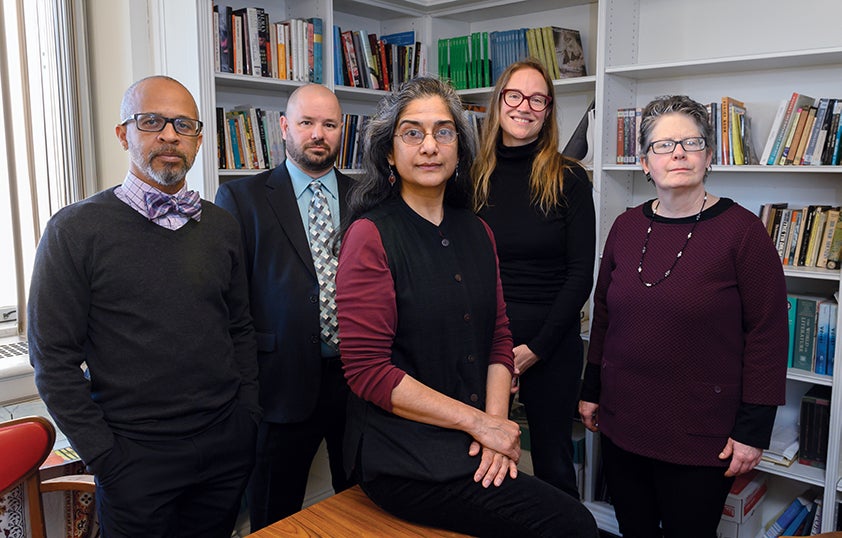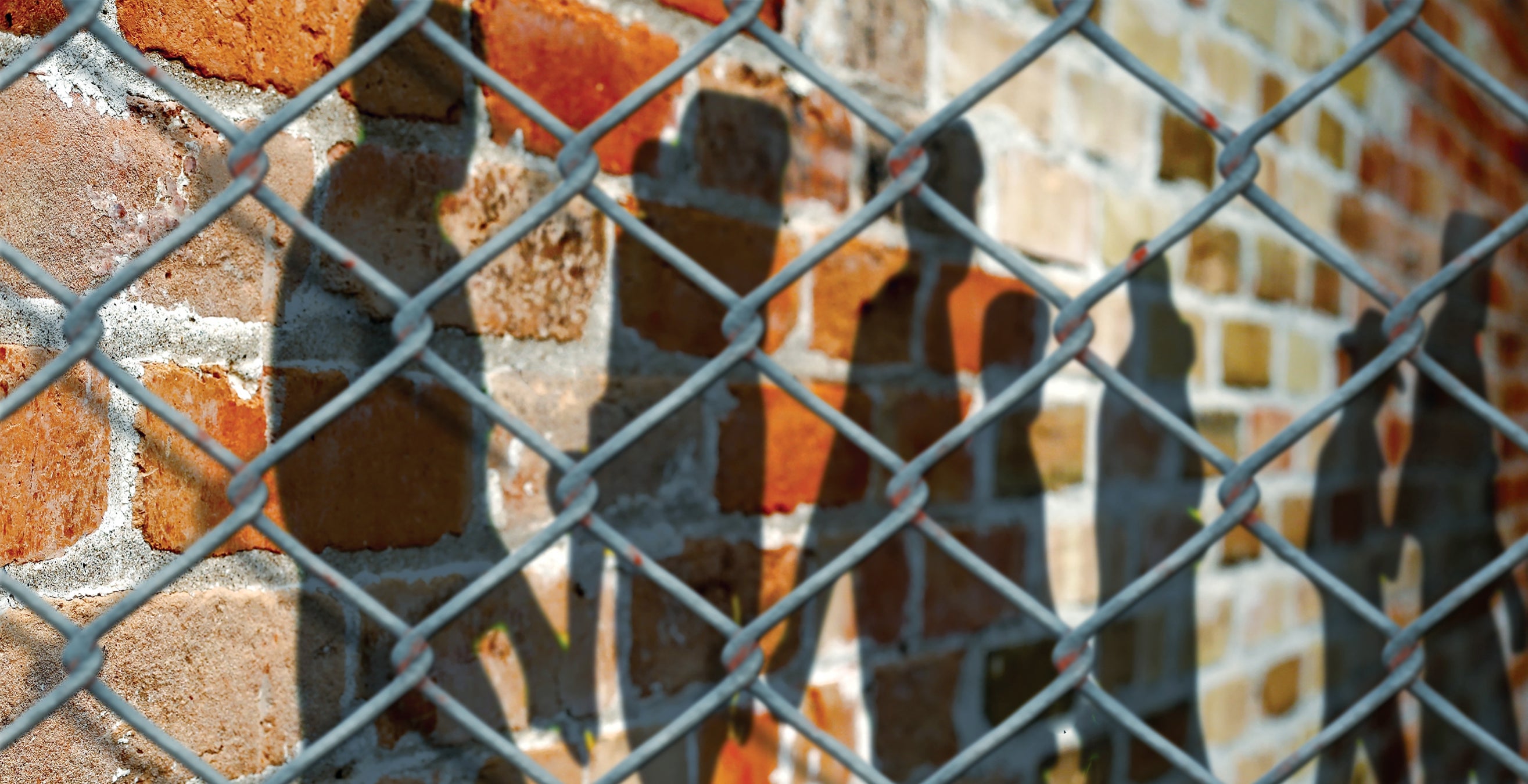To get to class each week, Matthew Broocke and 15 of his peers boarded a van in Pittsburgh and traveled nearly 50 miles south, beside the winding path of the Monongahela River, to a place few college students ever imagine visiting. Their destination: the State Correctional Institute—Fayette, a maximum-security prison.
It took them more than 90 minutes to reach its high gates.
Meanwhile, some of their classmates, like Sharef, had a much shorter commute. They were already on the inside.
Described by some as a city within a fence, SCI Fayette sits on more than 200 acres. Along with Sharef, there are nearly 2,000 incarcerated people and 690 employees. They have their own post office, medical center and fire department.
Largely, it’s a world without color. Many of the interior walls are beige. The inmates wear jumpsuits in shades of mud. The correctional officers wear shades of gray. To enter, Broocke, the other students and their Pitt instructors must walk past barbed wire and armed security. Their classroom is in the prison’s chapel, where they pull their plastic chairs into a wide circle. Rules abound. No touching. Conservative dress code. Students can’t share their last names or correspond beyond class.
 But, once the session kicks off, with discussion guided by a professor and fueled by the week’s assigned reading, the strange environment and the differences between them melt away. They’re all students, learning together and from one another.
But, once the session kicks off, with discussion guided by a professor and fueled by the week’s assigned reading, the strange environment and the differences between them melt away. They’re all students, learning together and from one another.
This a course by the Pitt Prison Education Project. It is taught in the style of Inside-Out, a global teaching and community engagement program where traditional college students learn and study with those serving time in prison, for either violent or nonviolent offenses. Inside-Out, which involves more than 150 campuses and correctional institutions, began in 1997. It was founded on the idea that education can change lives and create equality. The benefit isn’t meant only for those in jails and prisons. By bringing together incarcerated students and college students, the intention is to bridge gaps of difference, facilitate conversations and empower both parties to better understand and tackle social issues, including crime and justice.
Pitt launched its participation in 2017. A couple years earlier, Chris Bonneau, a professor of political science at the University, heard a National Public Radio story on the initiative. He was intrigued by the concept and impressed by what it offered students of all walks of life, particularly those in correctional institutions, where it is easy to lose a sense of purpose and self. As a teacher, he knows the power of education. He also has a relative who had been incarcerated. He knows that committing a crime doesn’t take away someone’s humanity.
There was little chance that Broocke and Sharef would have met without Inside-Out. The two men’s lives are profoundly divergent.
Sharef (not his real name) grew up in an economically depressed corner of the urban Northeast. It was a place of failed schools, drug dealing and high unemployment. Pitt sociologist and ethnographer Waverly Duck has written about how such crushing social dynamics lock residents into these harsh urban environments, too often predominantly Black, and render them too few choices.
“If people are excluded from and not able to prepare for what we call legitimate jobs and legitimate society,” he says, “they will turn to what is available—drug peddling, hustling. When you concentrate the poverty, you concentrate the disadvantage.”
Sharef says that, growing up, he saw no way out. The schools offered little relief. There were few male teachers who paid the young men any attention. Most of the educators had little in common with the students. “In many ways,” he says, “we failed because we were denied knowledge. We were only taught to use our muscle and not our brain. There was no one who could say to me, ‘If I stay off the corner, here’s how I’m going to eat.’”
He simply knew no way out. “I had to walk past drug dealers every day. In a community of 100,000 people, we had plenty of bars but only one library. You could have put some alternatives in front of me, I would not have known how to take advantage of them. … It’s a shot we couldn’t even see.”
Broocke is 10 years younger than Sharef. He grew up on the East Coast, too, in a sprawling suburban community outside of Washington, D.C., a city not that different demographically from where Sharef grew up. Broocke’s neighborhood, however, was mostly white and affluent.
Broocke is an only child to two college-educated parents. He recalls that the community’s expectations were that all the children would go to college.
“I remember there was a strong pressure to get into the best schools, get the best grades, hiring the tutors, choosing the right extracurriculars.”
His parents, he says, were not that rigid, though they encouraged their son to put forth his best effort and follow his passion. There were plenty of dinner conversations that reinforced ideas on responsibility, freedom and personal respect. Broocke was expected to do well in school; take care of the family’s pets; and save money from his part-time jobs as a barista, in retail, and at a nearby country club.
 He was drawn to civic engagement and international relations. In high school, he spent his free time rowing and participating with the Model United Nations. He was a curious young man, who, with his friends, questioned social norms. Around them, he could be himself: witty and intellectual.
He was drawn to civic engagement and international relations. In high school, he spent his free time rowing and participating with the Model United Nations. He was a curious young man, who, with his friends, questioned social norms. Around them, he could be himself: witty and intellectual.
Broocke never thought it was not possible to advance in life. His parents had the means, he had a good education, and he had the support of his teachers.
For Sharef, however, by the time he became a teenager, he found it difficult, confusing and frustrating to navigate his world. Although he was distant from his father, he knew of his cycle through ever-worsening fates. He spent time in jail and was ultimately killed in a street fight when Sharef was 12.
The death showed Sharef and his family how the social divisions of class, race and poverty ravaged lives—coarsening families and communities across generations. The chasms created a space where residents navigated a code, a set of informal rules that governed their daily lives and which could be vastly different from the mainstream.
One of the codes where he lived was either fight or be beaten. Fighting first was considered the “right” thing to do, he says. Neighbors were always fighting, and gyms were packed with guys learning to box. When he was younger, it was okay to fistfight, but not kill, he says—that was one of the codes of living there.
Broocke had a different kind of guidance. His high school was highly ranked among others in the nation. It was a place where 80% of its students participated in honors or advanced placement classes. In addition, he had access to highly motivated teachers who also served as mentors.
A social studies teacher guided Broocke’s leadership with the school’s Model United Nations program. He recognized the high school student’s civic passion and encouraged him to follow that in college.
Sharef, however, says he always saw the streets as the way up. “I was gonna hustle my way out of poverty,” he says.
By the time he was 19, he was making money selling drugs. He was also gaining a reputation as a rap music artist.
But the notoriety also bred envy. Rivals constantly sparked fistfights and disruptions at clubs and parties. One rival threatened Sharef and, then, his family. In response, Sharef made a decision that would soon prove disastrous. On a summer day, in an attempt to attack his rivals, he recklessly fired into a crowd, killing a bystander. He was convicted of third-degree murder and, at the age of 21, received a sentence of 20 to 40 years in prison. Not a day has gone by since then, he says, that he doesn’t regret his decision and the sorrow he caused.
Broocke, being community minded, was aware by high school that not everyone lived as comfortably as the physicians, teachers, engineers and government workers who lived around him. But he knew little of the day-to-day challenges of people like Sharef, locked into neighborhoods of boarded-up buildings and closed storefronts, mired among swaths of inequality.
When Broocke arrived at Pitt in fall 2016, he majored in political science and, eventually, became involved in the student group Pitt Prison Outreach, which aims to mobilize and inform students on issues of incarceration and criminal justice. As a junior, he enrolled in an Inside-Out class and not long after found himself sitting in a circle next to his classmate, Sharef.
For nearly three hours, the two of them and the other students bantered over the “Politics of Black Masculinity,” an anthropology class. For 10 weeks, the students in the circle explored the intersections of race, history, patriarchy, sexism. The discussions touched on culture, social change and the human heart. The exchanges could be tense. But everyone listened and learned from each other. When the class ended, Broocke and Sharef had become academic contemporaries, seeing the world through a similar lens, however briefly.
The possibility of such an outcome is what inspired Bonneau when the professor heard that NPR story. He wanted to get Pitt involved. To make it happen, he gathered with English professors Shalini Puri, Cory Holding and Nancy Glazener (now director of Gender, Sexuality and Women’s Studies) to talk about the importance of the University going to the people and integrating education in various communities, including the community of incarcerated people. They also had the support of the administrators at SCI Fayette, who recognized the transformative potential of the program.
More than 90% of those incarcerated are released, and studies show they fare better when they’re educated. So, why not take Pitt to SCI Fayette and turn the prison into a teaching center?
To do so, they founded the Pitt Prison Education Project. A couple of years later, in 2018, PPEP received a Chancellor’s SEED grant, which the group used to expand faculty, tutoring support and the disciplines in which they offer courses. More than 300 students, both inmates (inside) and college students (out), have taken PPEP courses.
PPEP teaches both Inside-Out and inside only courses. With the classes, the organizers and professors are tapping into the belief that one way to rehabilitate inmates is to expose them to a world of ideas, so Pitt has developed a range of class options: literature, political science, race and criminal justice, anthropology and more. The hope is that this broadened exposure will open the hearts and minds of the students, inside and out, to the possibility of new opportunities.
Part of the reason we’re here “is we like to think we can change tomorrow by being intentional with what we do today,” says Puri, who worked to create the Pitt Inside-Out program and teaches at SCI Fayette. “We believe in the right of all people to an education. And we have seen that, given the opportunity, our inside students excel.”
There are studies to show it could be good for society, as well. When the incarcerated learn, it reduces recidivism. A RAND Corp. study in 2013 found that inmates who took classes were 43% more likely to not return to prison, and 13% more likely to get a job after leaving confinement.
 In the years since its launch, Pitt’s Inside-Out program has grown. In the fall of 2019, it taught courses at SCI Somerset and SCI Laurel Highlands. Now, thanks to Pitt Provost Ann E. Cudd, Fayette students receive credit for the classes they take with Pitt professors.
In the years since its launch, Pitt’s Inside-Out program has grown. In the fall of 2019, it taught courses at SCI Somerset and SCI Laurel Highlands. Now, thanks to Pitt Provost Ann E. Cudd, Fayette students receive credit for the classes they take with Pitt professors.
Inside students are keen to share with other inmates the opportunity that education provided them. So, even when in-person classes were suspended at the prisons during COVID-19, professors Holding and Puri carried on, teaching a remote course to help inside students continue their education and develop their writing skills independently. Students in the class went on to produce the 180-page book “Write Now! A Guide by and for Incarcerated Writers.”
As an English professor, Puri understands how literature changes people from the inside, out. So, the experience at Fayette, to her, is “magical… an example of what is possible when people of good faith want to understand and learn from each other.”
Sharef took the classes for four years and says they changed him. He would regularly go back to his cell after class and spend hours looking up words to strengthen his vocabulary. He needed to do this to better process homework assignments. He welcomed a discipline toward learning that he had never fomented outside of Fayette.
Today, he says he is full of ideas, energized by the jolts of scholarship and interaction. “It’s like coming from outside the ’hood and knowing somebody cares,” says Sharef. When he’s released, he says, he wants to return to his hometown, create a nonprofit and work to create positive environments that can do for others what wasn’t done for him. His new life direction would also be a way, he says, to help make amends for the crime he so wishes never happened.
Broocke is changed, too. From sitting with the Fayette students, he’s now aware that devotion to learning can transcend the Pitt campus. He grew from thinking the experience would be something akin to the Scared Straight documentaries to being someone who stands up and speaks out when friends and others joke about people who are incarcerated. “Now I can dispel negative narratives about who they are,” he says.
And the class reconfirmed his desire to work in community organizing. Shortly after graduation in spring 2020, he found a position as a campaign organizer with the United Steelworkers, where he helps build support for the benefits of unionization and labor rights.
One other lesson Broocke says the class taught him—destinies are made not just by the decisions people make, but also by the resources available to them. He believes that in a world surrounded by walls, education and dialogue can help the light of possibility shine through.
This article appears in the Spring 2021 edition of Pitt Magazine.

